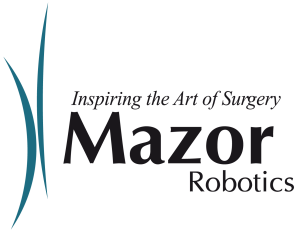 Mazor Robotic Renaissance™ System
Mazor Robotic Renaissance™ System
Request a Consultation 760.940.3000
Who Can It Help?
Mazor Allows More Safety, Accuracy
Mazor Robotics’ Renaissance™ is a specially-designed surgical guidance system that allows surgeons to perform safer and more accurate spine surgeries. For patients, this means better clinical outcomes with less pain, fewer complications and shorter recovery time. Renaissance is in daily use in leading hospitals with thousands of successful cases worldwide.
Spinal Surgery Options
It is the process of fusing two or more vertebrae together, immobilizing them to create a single continuous bone. It is used to treat broken vertebra, spinal deformity, spinal weakness, spinal instability or chronic low back pain.
Our surgeons use a bone graft in conjunction with the body’s natural bone growth processes so that bone growth can occur. This bone graft may be in a pre-formed shape or contained in a cage made out of plastic, carbon fiber or metal. Our surgeons often use implanted plates, screws or robs to hold the vertebrae and graft together to promote healing. Once this bone graft heals, the vertebrae are permanently fused.
What type of surgery is needed for spinal fusion?
Minimally invasive surgery (MIS) uses smaller incisions and usually results in less postoperative pain and faster recovery. MIS does, however, require many intraoperative X-rays to compensate for the surgeon’s lack of direct line-of-vision, which can make it less accurate than open surgeries.
Using Mazor Robotics technology allows our surgeons to overcome these limitations and perform precise spinal fusion with minimal radiation.
What are the advantages of spinal fusion with Mazor Robotics technology?
It guides the surgeon’s tools and the implants in both open and minimally invasive surgery, while ensuring the highest levels of accuracy of implant placement. It decreases soft tissue trauma, preserving surrounding healthy tissue.
Kyphoplasty is usually an outpatient procedure with local anesthesia for treating compression fractures of the spine — to stabilize the fracture and relieve the pain caused by the fracture.
What happens during the procedure?
During the procedure, synthetic bone cement is injected through a needle into the fractured vertebra to fill the spaces in the bone. After the needle is removed, the bone cement hardens in 10 minutes, stabilizing the fractured vertebra.
Finding the right spot for injection can be challenging. Surgeons must accurately place the needle in the precise location to avoid spillage., which can create pressure on the nerve canals. To compensate for the lack of direct visual accessibility, surgeons usually need high levels of X-ray radiation to guide them throughout the procedure.
What are the advantages of kyphoplasty with Mazor Robotics?
This technology allows our surgeons to create a preoperative surgical blueprint, which is a map for pinpointing the precise location for injecting the bone cement. In the operating room, the Mazor Robotics system guides the surgeon’s tools with minimal radiation.
A biopsy is the removal of a small sample of tissue for examination and diagnosis. For example, a biopsy is done to determine if the abnormal tissue is benign, malignant or infected. Biopsies can be as small as a millimeter (1/25th of an inch).
How is a biopsy performed?
Biopsies are usually taken with a needle through a small incision. To compensate for the lack of direct visual accessibility, surgeons use computed tomography (CT) and X-ray images to guide the biopsy. Finding the right spot can be difficult, especially with very small lesions. This increases the operation time, as well as radiation to the patient and may cause more tissue damage and a larger scar.
What are the advantages of biopsies performed with Mazor Robotics technology?
It allows our surgeons to create a preoperative surgical blueprint, which is a map for pinpointing the exact location for taking your biopsy. During the procedure, Mazor Robotics guides your surgeon according to your surgical blueprint, with minimal X-rays. This enhances safety by reducing exposure to radiation and minimizes soft tissue damage.
A normal spine, when viewed from behind, appears straight. However, a spine affected by scoliosis shows evidence of a lateral, or side-to-side curvature, with the spine looking like an “S” or “C” and a rotation of the back bones (vertebrae), giving the appearance that the person is leaning to one side. According to the Scoliosis Research Society, scoliosis is defined as a curvature of the spine measuring 10 degrees or greater.
Scoliosis is a type of spinal deformity and shouldn’t be confused with poor posture.
>Spinal curvature from scoliosis may occur on the right or left side of the spine, or on both sides in different sections. Both the thoracic (mid) and lumbar (lower) spine may be affected by scoliosis.
How can robotic surgery help?
Surgery treats but does not cure scoliosis; it corrects the abnormal curvature and prevents further progression of the disease.
In cases which are progressive, or when the cob angle is greater than 45º, your doctor may recommend surgery to straighten and fixate the spine, which is achieved by placing implants such as screws, rods and wires in and along the spine.
Though scoliosis is common in adolescents, we are not currently performing surgery on that age group. At Tri-City Medical Center, surgeons are utilizing the Mazor technology to correct scoliosis deformity in adults.
Surgery can offer significant pain relief and enhance daily living activities.
What are the advantages of treatment with Mazor Robotics technology?
Surgical treatment of adolescent idiopathic scoliosis requires planning and precision. Each scoliotic curvature has unique challenges and often the patient’s vertebrae are deformed, twisted and abnormally small, which makes surgery challenging.
Mazor Robotics technology provides increased safety and precision in corrective surgery. It allows our surgeons to plan ahead before entering the operating room. Mazor Robotics advanced 3D planning software is used before surgery to create a unique blueprint, which is the ideal procedure for each patient’s condition.

